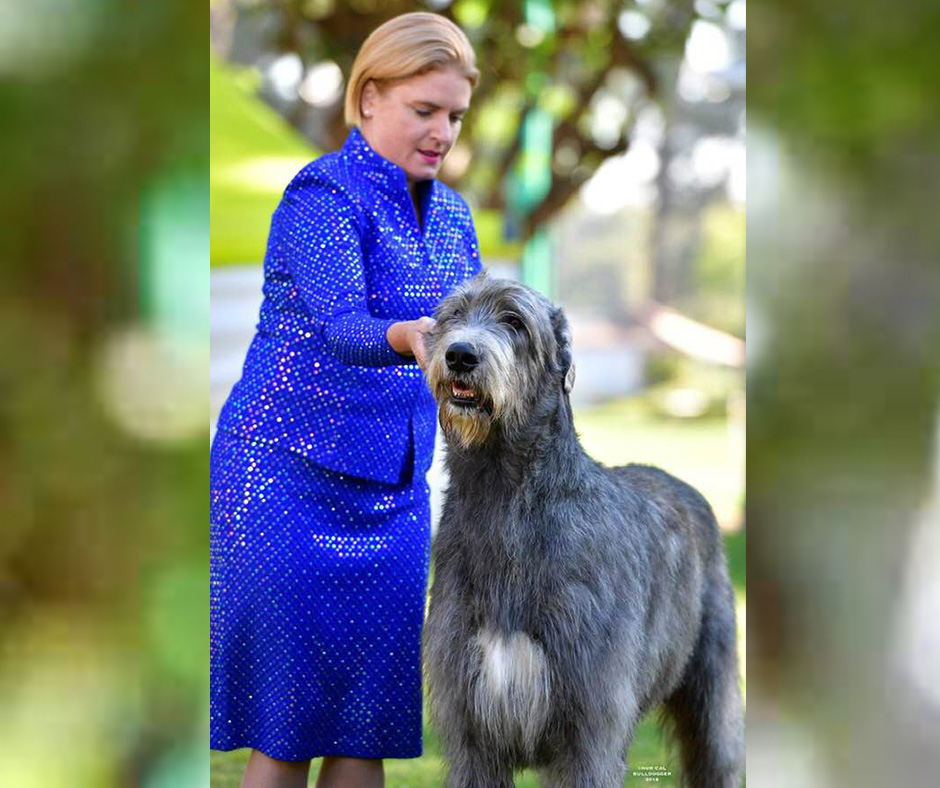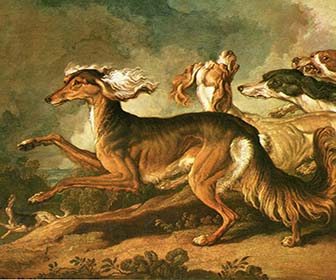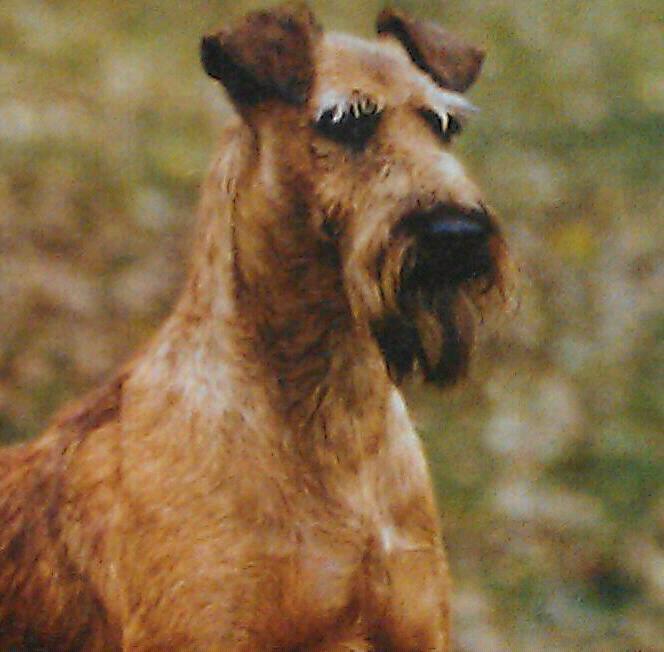674 – Irish Wolfhounds: Soulful Gentle Giants
Irish Wolfhounds: Soulful Gentle Giants
Love the Breeds returns as host Laura Reeves talks with Jamie Souza Bartlett about Irish Wolfhounds, the gentle giants of the dog world.
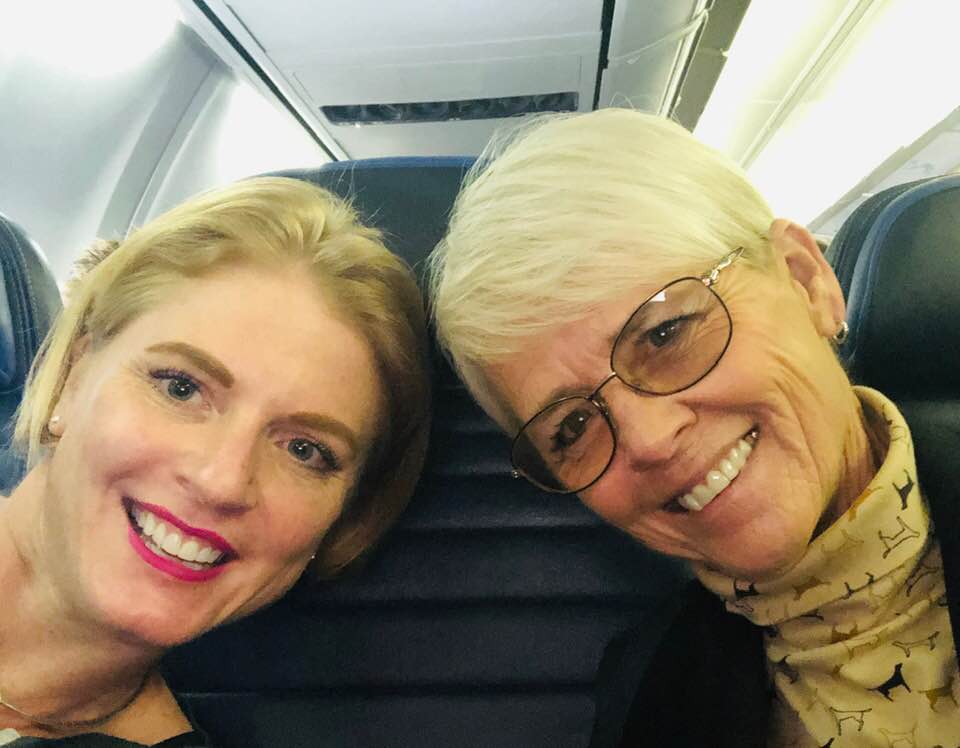
Jamie grew up with Irish Wolfhounds with her mom, Linda Souza.
“They’re just, they’re soulful, they’re sweet. They’re the gentle giants and I was very, very fortunate to grow up with them,” Jamie says.
“Wolfhounds, much like a lot of breeds, were bred for a specific purpose, which was to hunt wolves in Ireland. Eventually, the wolves became extinct in Ireland, and consequently the wolfhounds almost became extinct. And then several years later Captain Graham came along and really found that this was a breed that required rejuvenation and real, real rescuing and bringing back because they’re just so wonderful.
“You don’t own wolfhounds, you’re owned by them. It’s not an easy breed to have by any means. It comes with its own set of issues. But when you do own them and you’re owned by them, there’s just really no greater thing in the world. They are so soulful and so wonderful and like, you become part wolfhound.
Feeding
“As a young dog, they eat quite a bit because you’re looking at a puppy that is a pound when it’s born and it’ll be 100 pounds by the time it’s six months old. So the growth rate is very rapid and they do eat quite a bit as babies. And then quite quickly, once they kind of reach their full height it curbs significantly because you’re not looking at a dog that’s like a Doberman or something that’s constantly pacing, constantly moving around. They will have bursts of energy. Big burst of energy in the morning, big burst of energy when it gets cold at night, and the rest of the time they’re chilling. So they really don’t eat as much as an adult as one would think, considering their size.

Puppies in the breed grow fast!
“I always encourage anybody to listen to their breeder and their breeding program because different lines tend to evolve differently and grow at different rates. We were always just really careful. We wanted them off of puppy food and anything that was promoting rapid growth as quickly as possible. We’re trying to do things that are keeping them from growing too fast, which is kind of like the opposite of what a lot of other people do or they want them to like beef up. Really, that’s absolutely what we don’t want to do.
Exercise
“We also have a lot of protocols, not just around food, but around exercise. And we tell all of our new puppy buyers like you have to be very, very careful with this breed as they’re growing up. And again, the inclination is like, ‘ohh, I got a puppy and I want it to go run around and play with my other dogs and I want it to be jumping around and being goofy’ and it’s just a hard no.
“Until these dogs’ growth plates close you can do really, really irreparable damage and we tell people don’t take them into the hotel rooms and let them jump on the beds and jump down, you don’t want all that impact on them as they’re growing. Once they hit that two year old range then we’ll start putting them out carefully with other dogs. It was one of the great things actually about having whippets. My whippets are fantastic exercising our wolfhound puppies, right, because there was no to low impact, but it helped with their movement. They’re running, but kept them developmentally in a good place where they weren’t getting injuries to the shoulders or elbows or anything else.”
503 – Examining the History of Sighthounds with Bo Bengtson
Examining the History of Sighthounds with Bo Bengtson
Bo Bengtson, author, publisher and Whippet breeder, attended his first dog show in 1958 in his native Sweden. He joins host Laura Reeves for a deep dive into the intricacies of sighthounds.
“It was, right away, like lightning struck,” Bengtson said. “I was 14 years old and I just knew right away that this was what I wanted to devote my life to. It was really fascinating. It was, as someone once said, a combination of zoo and circus and theater …
A passion for sighthounds
“You have to know a little bit about coursing if you’re involved in sighthounds. They have remained the same for thousands of years, the basic type. They weren’t breeds early on but different types of sighthounds. if you look at the early description of coursing which is the pursuit of game with sighthounds … that is a sport that’s now these days illegal in most of US… It’s been superseded by lure coursing, which is an artificial form of coursing.

“Hunters Homeward Bound,” 10th Century AD. Courtesy of Bo Bengston.
“(Sighthounds developed) before firearms basically, when the only way you had to hunt was through the dogs and whatever they could course and kill was basically today’s dinner. Firearms made sighthounds very much superfluous. And I think the sport then became very much a status symbol. (Sighthounds) are of course aesthetically pleasing and so many rich people and aristocratic people preferred to hunt with sighthounds, not because of need but because it was a beautiful spectacle and pretty expensive spectacle too. In various parts of the world, Queen Elizabeth I was very fond of coursing. In Russia they coursed with Borzoi. And in the Far East there were Salukis.
What IS a Sighthound?
“There is no official definition of what a sighthound is. So there is a great disagreement about what breeds actually count as sighthounds. You can count as few as four or five as pure sighthounds and as many as 40 as “sighthound related” or different types of breeds we don’t know in this country. Some we wouldn’t define as breeds but more as types.
(Listen to fascinating conversations about the Caravan Hounds of India here and here.)
History of sighthound development
“I think we have to go back again a couple of thousand years because there have probably always been different sizes of greyhounds. Greyhound types. The big ones which were the ancestor of the modern greyhound. And we have the different, smaller ones that were ancestors of whippet and the Italian greyhounds. I think that Whippets, although they weren’t described as a breed until late 1800s, they have certainly been around much longer. Catherine the Great of Russia had little English greyhounds she called them. And they were very important to her. She nursed them herself and they slept on a pink couch in her bedroom. But whether they’re Italian greyhounds, whether they were whippet, who knows. I mean they were very small and whether Italian greyhounds or whippets, it is kind of irrelevant these days.
“The Greyhound and the Saluki are sort of the “ur” sighthound, what sighthounds are supposed to be like. … if you take one step away from Saluki you get the Afghan Hound, which is a little more powerful. If you take several steps away from the Greyhound, you get the Ibizan Hound and you get the Portuguese Podengo and that kind of thing.”
Listen to the full episode for more detailed insights into all things sighthound.
316 — Ireland’s “Heritage Status” for Native Dog Breeds
Ireland Designates “Heritage Status” for Native Dog Breeds
Sean Delmar, president of the Irish Kennel Club and Kerry Blue Terrier breeder, has just achieved the holy grail of “heritage status” for the nine native Irish breeds.
Heritage Status
JULY 16, 2019
I am pleased to announce that the 9 Irish Breeds have been granted National Heritage status by the Minister.
This is a wonderful step in the future protection and development of our amazing Irish Breeds and comes after many years of representations by those committed to Irish Breeds.
On behalf of The Irish Kennel Club I would like to specifically acknowledge the commitment of the following who put there heart and soul into making this a reality. Cathy Delmar, Eddie Burke, Vincent Flannelly.
Sean Delmar, President
“I thought there was a chance these breeds could go out of existence,” Delmar said. “I thought the Government should take some responsibility. We wanted to convince them these dog breeds are part of the patchwork quilt of the Irish people.”
This exciting success required a lot of initiatives over 10 years, Delmar noted. The small group of folks involved did demonstrations, paraded dogs at schools, had dogs on “chat shows” on TV.
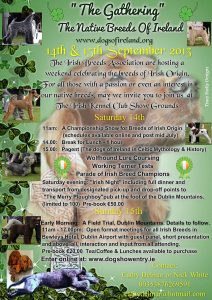 “We built up a portfolio so we had something to show the government, not just an idea,” Delmar said. “We created a heritage weekend revolving around dogs. Even hawking with setters in the midland bogs. People learned a lot about Irish breeds. The general populace is now more aware.”
“We built up a portfolio so we had something to show the government, not just an idea,” Delmar said. “We created a heritage weekend revolving around dogs. Even hawking with setters in the midland bogs. People learned a lot about Irish breeds. The general populace is now more aware.”
The Irish Kennel Club was only the national body that made the application. So much enthusiasm and work done was from a handful of devoted fanciers, Delmar said.
“Dogs developed because of working ability originally,” Delmar observed. “Ireland has the Irish Wolfhound and Kerry Beagle, Red setter, Red and white setter and Water spaniel. In the terrier group we have Kerry Blue, Irish, Glen of Imaal, Soft Coated Wheaten.”
Purebred dogs are history and art
Wolfhounds are one of the ancient symbols of Ireland along with the shamrock and harp. Kerry beagle are a hunting pack unique to Ireland. During the potato famine in Ireland, ships carrying refugees to the US, took Kerry beagles with them. Delmar expects these dogs could be found behind coonhounds in the US.
Romantic figures in Irish history hunted on horseback with hawks and setters, using nets before guns were invented.
Delmar’s telling of the rich tapestry of Irish history, includes Grace O’Malley — one of the earliest known female pirates, born around 1530 in Ireland and growing up to lead a 20-ship fleet. Her contribution to the development of the Irish Water Spaniel was the connection to her incursions on the Iberian Peninsula.
“We just undersell everything we do,” Delmar said. “We don’t spend enough time telling people that what you get with pedigree dogs is predictable qualities, predictable characteristics. Don’t get that in crossbreds. Can be great dogs. They might have one or two of the qualities. But it’s a lucky get. Like Forrest Gump’s box of chocolates.”

